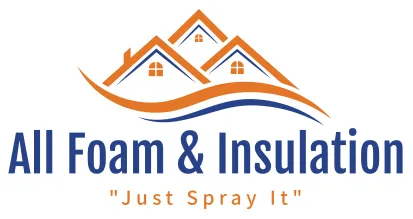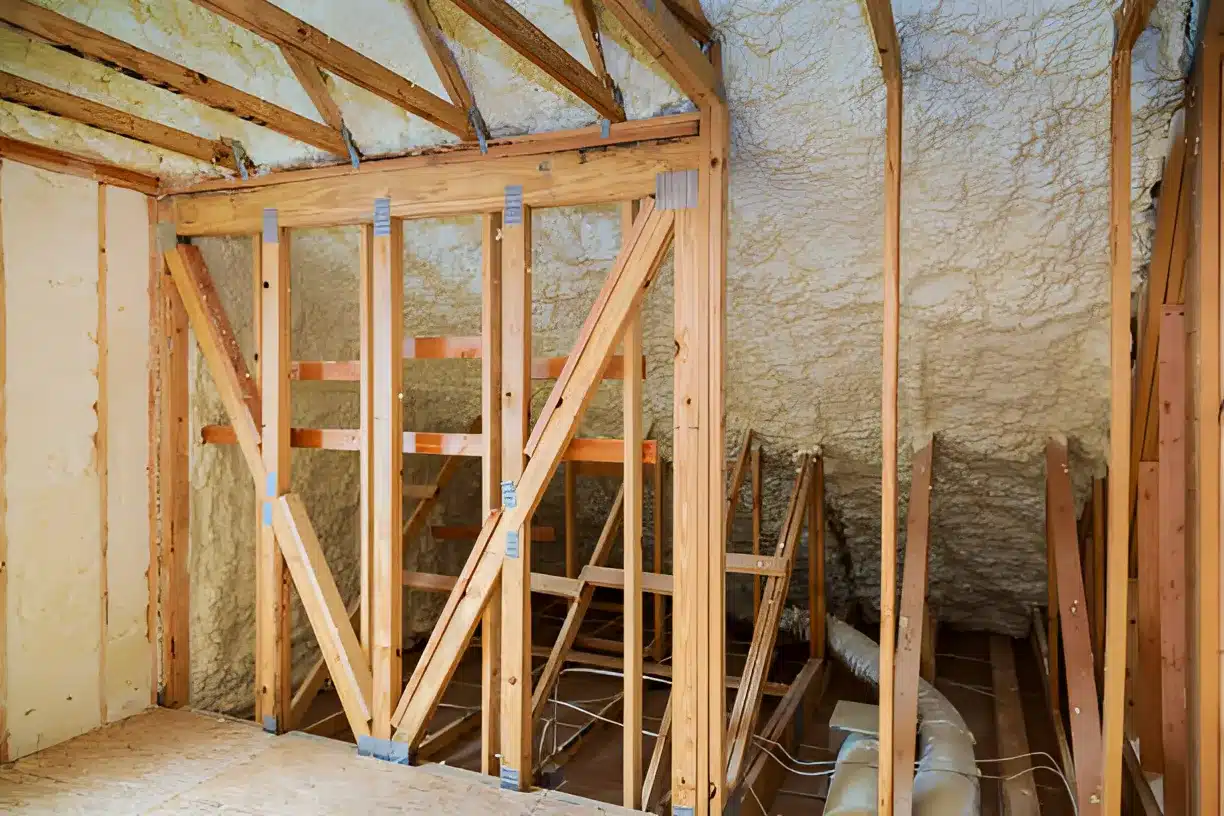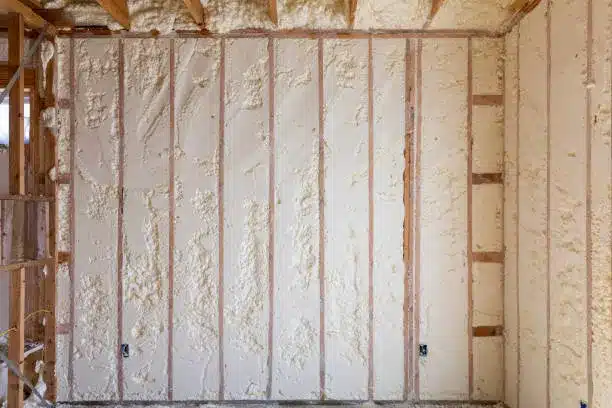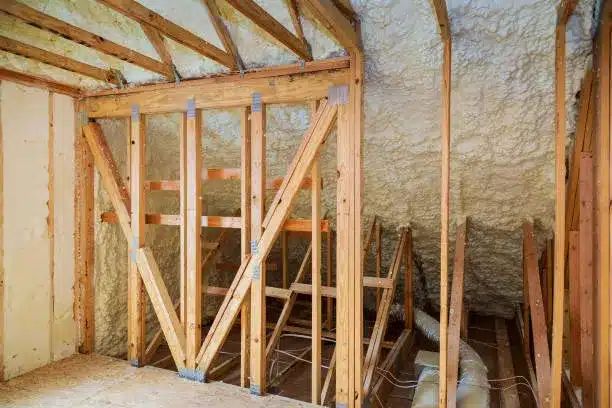Spray foam insulation prevents energy loss in older homes by creating an airtight thermal barrier that eliminates air infiltration and conductive heat transfer. Unlike traditional insulation materials that leave gaps and settle over time, spray foam expands to fill every crack, crevice, and irregular space in wall cavities, attics, and basements. This comprehensive sealing approach addresses the primary energy loss mechanisms that plague older structures built before modern building codes required continuous insulation and vapor barriers.
Older homes typically lose 25-40% of their conditioned air through uncontrolled air leakage, making spray foam application particularly effective for reducing energy consumption. The material’s dual function as both insulation and air barrier creates a unified building envelope that maintains consistent indoor temperatures while reducing HVAC system workload. Professional installation techniques ensure optimal coverage and performance, maximizing energy savings potential in structures where traditional insulation methods fall short.
Understanding Energy Loss Patterns in Older Homes
Older residential structures experience energy loss through three primary mechanisms: conduction, convection, and radiation. Conductive heat transfer occurs when temperature differences drive energy through building materials, while convective losses happen when air movement carries heated or cooled air outside the building envelope. Radiative heat transfer involves electromagnetic energy transmission through surfaces and openings.
Traditional building materials in older homes create thermal bridges that allow continuous heat flow. Wood framing, single-pane windows, and minimal insulation create pathways for energy loss that modern construction methods specifically address. Air leakage rates in homes built before 1980 often exceed 10-15 air changes per hour, compared to modern standards of 3-5 air changes per hour for energy-efficient construction.
Bonus Tip: Thermal imaging surveys reveal that older homes commonly lose energy through rim joists, wall-to-foundation connections, and attic bypasses that remain invisible during standard inspections.
How Spray Foam Creates Thermal Barriers
Spray foam insulation functions by expanding upon application to create continuous thermal barriers that eliminate air movement and reduce heat transfer. The material’s cellular structure traps air within millions of tiny bubbles, creating high R-values while simultaneously preventing air infiltration. This dual-action approach addresses both insulation and air sealing requirements with a single application.
Chemical reactions during spray foam installation cause the material to expand 30-100 times its liquid volume, depending on formulation. This expansion ensures complete coverage around irregular surfaces, pipes, electrical fixtures, and structural elements that traditional insulation cannot accommodate. The resulting barrier maintains its shape and effectiveness over decades without settling or degrading.
| Spray Foam Performance Characteristics | Closed-Cell | Open-Cell |
|---|---|---|
| R-Value per inch | 6.0-7.0 | 3.6-4.0 |
| Air permeability | 0.02 perms | 16-20 perms |
| Moisture resistance | Excellent | Moderate |
| Expansion ratio | 30-35x | 80-100x |
| Density (pounds per cubic foot) | 1.8-2.2 | 0.4-0.6 |
Sealing Common Air Leakage Points
Spray foam applications target specific areas where older homes experience significant air leakage. Basement rim joists, attic bypasses, and wall-to-foundation connections represent critical sealing opportunities that traditional insulation methods cannot address effectively. These areas often account for 30-50% of total air leakage in older structures.
Foundation penetrations, including utility lines, plumbing, and electrical connections, create numerous small openings that collectively contribute to substantial energy loss. Spray foam’s ability to expand and conform to irregular shapes makes it ideal for sealing these complex geometries. The material adheres directly to multiple surfaces simultaneously, creating durable seals that maintain effectiveness over time.
Attic floor bypasses, including recessed lighting fixtures, plumbing chases, and electrical penetrations, allow conditioned air to escape directly into unconditioned spaces. According to Department of Energy studies, sealing these bypasses can reduce heating and cooling costs by 10-20% in older homes. Spray foam applications in these areas provide both thermal insulation and air sealing in a single installation step.
Bonus Tip: Prioritize sealing the largest air leakage sources first, as the 80/20 rule applies to air sealing – 80% of air leakage typically occurs through 20% of the total opening area.
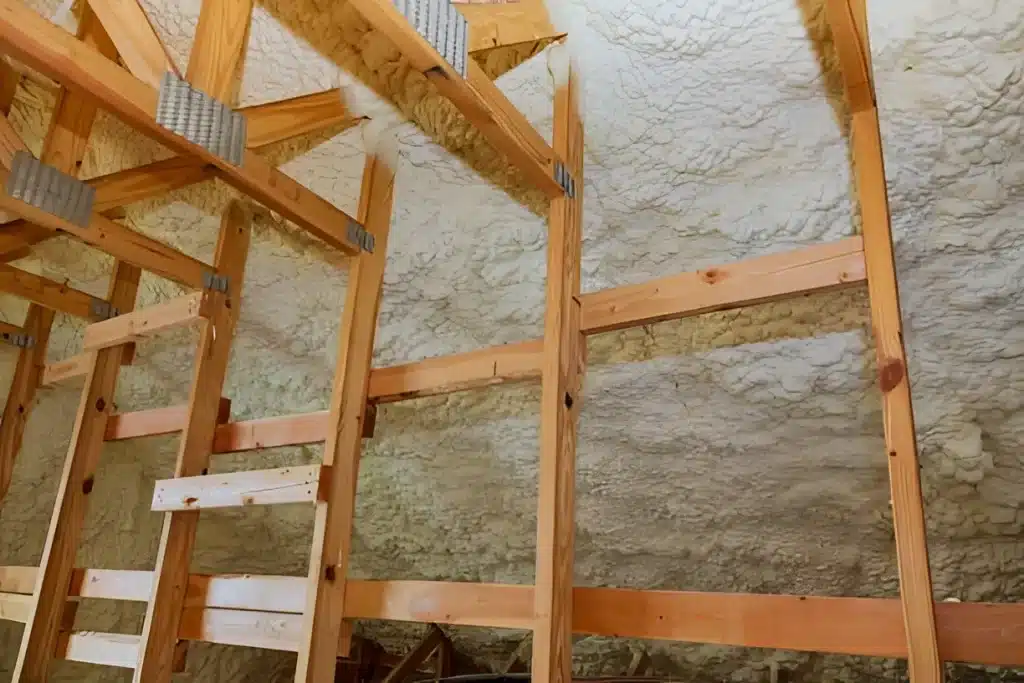
Moisture Management and Vapor Control
Spray foam insulation provides superior moisture management compared to traditional insulation materials in older homes. Closed-cell spray foam acts as a vapor barrier, preventing moisture transmission through wall assemblies while maintaining structural integrity. This moisture control prevents condensation within wall cavities that can lead to mold growth and structural damage.
Older homes often lack proper vapor barriers, creating conditions where moisture accumulates within wall assemblies during heating and cooling seasons. Spray foam applications create controlled moisture environments that eliminate these problems. The material’s impermeability to water vapor prevents condensation while its structural properties add rigidity to wall assemblies.
Open-cell spray foam allows controlled moisture transmission while providing excellent thermal performance. This characteristic makes it suitable for applications where complete vapor barriers are unnecessary or where building codes require vapor-permeable insulation systems. The material’s ability to dry out if exposed to moisture prevents long-term moisture accumulation issues.
Long-Term Performance and Durability
Spray foam insulation maintains its thermal performance and air sealing properties over decades without degradation. Unlike traditional insulation materials that settle, compress, or lose effectiveness over time, spray foam retains its original thickness and R-value throughout its service life. This stability ensures consistent energy savings and comfort levels in older homes.
The material’s adhesive properties create permanent bonds with building surfaces that resist displacement from air movement, vibration, or settling. These characteristics make spray foam particularly suitable for older homes where structural movement and settling may compromise traditional insulation installations. Professional installation techniques ensure optimal adhesion and coverage for maximum long-term performance.
According to Building Science Corporation research, properly installed spray foam insulation can maintain its effectiveness for 50+ years in residential applications. This longevity makes it a cost-effective solution for older homes where multiple insulation upgrades might otherwise be necessary over time.
Professional Installation Techniques
Spray foam installation requires specialized equipment and training to achieve optimal results. Professional installers use heated application systems that maintain precise temperature and pressure ratios for proper chemical reactions. Surface preparation, including cleaning and moisture management, ensures optimal adhesion and performance.
Installation techniques vary based on application areas and foam types. Wall cavity applications require different approaches than attic floor or basement installations. Professional installers assess each situation to determine optimal application methods, thickness requirements, and curing conditions for maximum effectiveness.
Quality control measures during installation include thickness verification, coverage inspection, and curing monitoring. These steps ensure that the finished installation meets performance specifications and building code requirements. Professional installation also includes safety protocols for handling chemicals and managing ventilation during application.
Things to Consider Before Making a Decision
Climate conditions significantly impact spray foam performance and installation requirements. Cold weather applications require heated substrate preparation and extended curing times, while hot weather installations may require adjusted chemical ratios and application techniques. Regional building codes may specify particular foam types or installation methods based on local climate conditions.
Existing building conditions affect installation approaches and expected results. Homes with extensive air leakage may require preliminary sealing of large openings before spray foam application. Moisture problems must be addressed before installation to prevent trapped moisture issues. Structural modifications or repairs may be necessary to accommodate spray foam installation in some older homes.
Building code compliance varies by location and application area. Some jurisdictions require specific foam types, thickness requirements, or fire-rated coverings for spray foam installations. Permit requirements and inspection procedures should be verified before beginning work. Professional installers typically handle code compliance and permitting requirements.
Comprehensive Insulation Solutions Available
All Foam & Insulation, LLC provides complete insulation solutions designed specifically for older home energy efficiency challenges. These services address the unique requirements of retrofit applications in existing structures.
- Closed-Cell Spray Foam: High-performance insulation and air barrier system that provides maximum R-value and moisture resistance for critical sealing applications
- Open-Cell Spray Foam: Cost-effective thermal insulation solution that provides excellent air sealing while allowing controlled moisture transmission
- Blown-In Insulation: Complementary insulation method for areas where spray foam application is not optimal or cost-effective
- Fiberglass Batt Insulation: Traditional insulation option for specific applications where spray foam is not required or appropriate
Maximizing Energy Efficiency Results
Spray foam insulation delivers optimal energy savings when combined with comprehensive building envelope improvements. Air sealing, window upgrades, and HVAC system optimization work together to maximize efficiency gains in older homes. Professional energy audits identify the most effective combination of improvements for each specific situation.
Timing spray foam installation with other home improvements maximizes both cost-effectiveness and performance results. Coordinating electrical, plumbing, and HVAC work with insulation installation reduces disruption and ensures optimal system integration. Professional project management ensures proper sequencing and quality control throughout the improvement process.
Bonus Tip: Consider upgrading HVAC equipment after spray foam installation, as reduced heating and cooling loads may allow for smaller, more efficient systems that provide better comfort control and lower operating costs.
Get Professional Energy Efficiency Solutions
Achieving maximum energy savings in older homes requires professional assessment and installation of appropriate insulation solutions. All Foam & Insulation, LLC provides comprehensive evaluation services that identify the most effective approaches for each specific situation. Expert installation ensures optimal performance and long-term reliability.
Professional consultation addresses specific concerns about existing building conditions, code compliance, and expected performance results. Detailed project planning ensures proper preparation, efficient installation, and quality control throughout the process. Contact All Foam & Insulation, LLC at (541) 826-9600 or [email protected] to schedule a comprehensive energy efficiency assessment for your older home.
Common Questions About Spray Foam Applications
What preparation is required before spray foam installation?
Surface cleaning, moisture control, and temperature conditioning are essential preparation steps. Areas must be dry, clean, and within specific temperature ranges for proper foam adhesion and expansion. Electrical and plumbing work should be completed before foam application.
How long does spray foam take to cure completely?
Initial curing occurs within minutes of application, but complete curing takes 24-48 hours depending on foam type, thickness, and environmental conditions. Ventilation requirements and re-occupancy timing vary based on foam formulation and application area.
Can spray foam be applied over existing insulation?
Spray foam can be applied over some existing insulation materials, but assessment of existing conditions is necessary. Moisture problems, pest issues, or degraded insulation should be addressed before new foam application. Professional evaluation determines the best approach for each situation.
What maintenance does spray foam insulation require?
Properly installed spray foam requires minimal maintenance over its service life. Periodic visual inspections for damage or displacement may be necessary, particularly in areas exposed to physical contact or extreme temperature changes. Repairs are typically straightforward with professional assessment.
How does spray foam installation affect indoor air quality?
Professional spray foam installation with proper ventilation and curing procedures does not negatively impact indoor air quality. Low-emission foam formulations are available for sensitive applications. Proper installation and curing eliminate off-gassing concerns associated with some foam products.

